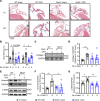Chronic kidney disease promotes atrial fibrillation via inflammasome pathway activation
- PMID: 37581942
- PMCID: PMC10541185
- DOI: 10.1172/JCI167517
Chronic kidney disease promotes atrial fibrillation via inflammasome pathway activation
Abstract
Chronic kidney disease (CKD) is associated with a higher risk of atrial fibrillation (AF). The mechanistic link between CKD and AF remains elusive. IL-1β, a main effector of NLR family pyrin domain-containing 3 (NLRP3) inflammasome activation, is a key modulator of conditions associated with inflammation, such as AF and CKD. Circulating IL-1β levels were elevated in patients with CKD who had AF (versus patients with CKD in sinus rhythm). Moreover, NLRP3 activity was enhanced in atria of patients with CKD. To elucidate the role of NLRP3/IL-1β signaling in the pathogenesis of CKD-induced AF, Nlrp3-/- and WT mice were subjected to a 2-stage subtotal nephrectomy protocol to induce CKD. Four weeks after surgery, IL-1β levels in serum and atrial tissue were increased in WT CKD (WT-CKD) mice versus sham-operated WT (WT-sham) mice. The increased susceptibility to pacing-induced AF and the longer AF duration in WT-CKD mice were associated with an abbreviated atrial effective refractory period, enlarged atria, and atrial fibrosis. Genetic inhibition of NLRP3 in Nlrp3-/- mice or neutralizing anti-IL-1β antibodies effectively reduced IL-1β levels, normalized left atrial dimensions, and reduced fibrosis and the incidence of AF. These data suggest that CKD creates a substrate for AF development by activating the NLRP3 inflammasome in atria, which is associated with structural and electrical remodeling. Neutralizing IL-1β antibodies may be beneficial in preventing CKD-induced AF.
Keywords: Arrhythmias; Cardiology; Chronic kidney disease.
Figures







Comment in
-
Inflammasome activation: unraveling the link between chronic kidney disease and atrial fibrillation.Kidney Int. 2024 Jul;106(1):6-9. doi: 10.1016/j.kint.2024.01.033. Kidney Int. 2024. PMID: 38906654 No abstract available.
References
-
- Fuster V, et al. ACC/AHA/ESC 2006 guidelines for the management of patients with atrial fibrillation-executive summary: a report of the American College of Cardiology/American Heart Association Task Force on Practice Guidelines and the European Society of Cardiology Committee for Practice Guidelines (Writing Committee to Revise the 2001 Guidelines for the Management of Patients with Atrial Fibrillation) Eur Heart J. 2006;48(4):854–2030. doi: 10.1016/j.jacc.2006.07.009. - DOI - PubMed

